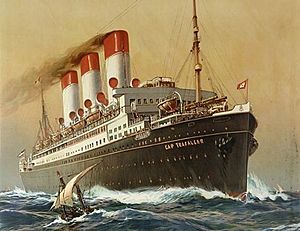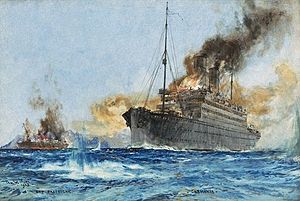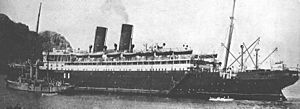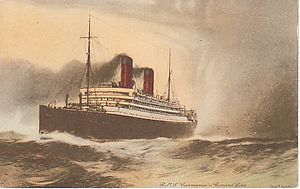SMS Cap Trafalgar facts for kids
Quick facts for kids  |
|
| History | |
|---|---|
| Name | Cap Trafalgar |
| Namesake | Cape Trafalgar |
| Owner | Hamburg Südamerikanische Dampfschifffahrts-Gesellschaft |
| Builder | AG Vulcan, Hamburg |
| Yard number | 334 |
| Launched | 31 July 1913 |
| In service | 1 April 1914 |
| Homeport | Hamburg |
| Fate | Sunk in combat, 14 September 1914 |
| General characteristics | |
| Tonnage | 18,710 GRT |
| Displacement | 23,640 tons |
| Length | 613 ft (187 m) |
| Beam | 72 ft (22 m) |
| Installed power | 15,000 shaft horsepower |
| Propulsion | Twin steam 4-cylinder triple expansion engines with turbines; 3 propellers |
| Speed | 17 knots |
The SS Cap Trafalgar was a large German ocean liner. It was built in 1913. Ocean liners are big passenger ships that travel across oceans. In 1914, the ship was changed to be a warship for World War I. It became an auxiliary cruiser, which is a merchant ship armed for battle.
Cap Trafalgar was the first armed merchant ship sunk by another ship of the same type. It was destroyed by HMS Carmania. This British ship was also a converted ocean liner. They fought a fierce battle in the South Atlantic in September 1914. This was the world's first battle between two former passenger ships.
Early Life of the Ship
The passenger ship SS Cap Trafalgar was built in Hamburg, Germany. It was made for the Hamburg-South America Line. This company ran trips between Germany and the River Plate in South America. The ship was named after Cape Trafalgar in Spain. This cape was famous for the Battle of Trafalgar in 1805.
The Cap Trafalgar had three funnels. It was 613 ft (187 m) long and 72 ft (22 m) wide. It weighed 18,710 GRT. This ship could carry almost 1,600 passengers. It had different classes, from first class to steerage. Its outer propellers were powered by steam engines. A steam turbine drove the middle propeller.
The Cap Trafalgar started its first trip, called its maiden voyage, on April 10, 1914. It sailed from Hamburg to ports in South America. These included cities in Brazil, Argentina, and Uruguay. At that time, it was the biggest and most luxurious ship on the South American route.
The ship had a swimming pool and a cafe on its upper decks. Its first-class areas were very fancy. They had beautiful gold decorations. The rooms were furnished in the best style of the time. The Cap Trafalgar showed off great style and German engineering. But when World War I began, its life as a luxury liner ended.
The Sinking of Cap Trafalgar
| Sinking of SMS Cap Trafalgar | |||||||
|---|---|---|---|---|---|---|---|
| Part of Atlantic U-boat campaign of World War I | |||||||
 Carmania sinking Cap Trafalgar |
|||||||
|
|||||||
| Belligerents | |||||||
| Commanders and leaders | |||||||
| Strength | |||||||
| SMS Cap Trafalgar | HMS Carmania | ||||||
| Casualties and losses | |||||||
|
|
||||||
When war started in Europe in August 1914, Cap Trafalgar was in Buenos Aires. The German Navy took over the ship. They wanted to use it as an auxiliary cruiser. On August 18, it went to Montevideo for coal. Then it sailed to a secret meeting spot. This was the remote Brazilian island of Trindade.
At Trindade, the gunboat SMS Eber transferred naval officers, weapons, and ammunition to the liner. Cap Trafalgar's third funnel was fake, so it was removed. The ship was armed with two 4.1-inch guns. It also had six "pom-pom" guns. These were named for the sound they made. Experienced sailors operated all the weapons.
The Cap Trafalgar's job was to sink British merchant ships. It was given the code name Hilfskreuzer B. Korvettenkapitän Wirth was its commander. After a first trip with no success, Cap Trafalgar returned to Trindade Island. It arrived on September 13 to get more fuel from German supply ships.
The RMS Carmania was a British ocean liner. It was built for the Cunard Line. It started its first trip in December 1905. When World War I began, Carmania was also turned into an armed merchant cruiser. It was given eight 4.7-inch guns. Captain Noel Grant was its commander.
On September 14, Carmania found Cap Trafalgar at Trindade Island. Carmania had been sent to find German supply ships and small warships. These ships might be using the island as a base. Carmania saw smoke from Cap Trafalgar early in the morning. Hours later, it surprised the German ship and two supply ships in the island's only harbor.
The Cap Trafalgar was disguised as the Carmania. Its only battle was against the real Carmania. Both captains knew they needed a lot of space to fight. So, they sailed several miles away from Trindade Island. This gave them room to maneuver.
The two ships then turned towards each other and began to fight. Carmania fired too early. This allowed Cap Trafalgar to hit first. Carmania was hit 79 times. It had a hole below the water line. Its bridge was completely destroyed by shells.
But as the ships got closer, Carmania's guns also caused damage. Fires started on both ships. Sailors even fired machine guns at each other as the ships came very close. Neither ship had modern fire control. So, the battle was fought like in old times. Ammunition was brought to the guns by hand. Guns fired as they aimed at the target.
Just when it seemed Carmania's fires would get out of control, Cap Trafalgar turned away. It began lowering lifeboats. The ship was leaning heavily to one side. A shell below the waterline had broken many parts. The ship was sinking fast.
However, the supply ships were able to rescue 279 sailors. Fifty-one people died in the fighting or sinking. This included Captain Wirth. Carmania was also badly damaged. It was leaning, heavily flooded, and burning. Nine of its men died, and many more were hurt.
At this point, another German armed merchant cruiser arrived. This was the SS Kronprinz Wilhelm. It seemed ready to finish off the damaged Carmania. But its captain feared a trap. Many ships had heard Cap Trafalgar's distress calls. Carmania had also sent messages in British code. Since other warships were on their way, and Cap Trafalgar had likely sunk, the captain of Kronprinz Wilhelm sailed away without firing.
The Carmania was barely floating. It was leaning badly. Fires burned, and its communication and navigation tools were almost destroyed. It turned and sped south. It hoped to meet a British cruiser. By the time it was rescued on September 15, it was hardly able to sail. It probably would have sunk if it stayed at sea much longer.
The next day, Carmania was rescued. Other ships of the Royal Navy brought it to Pernambuco. The survivors from Cap Trafalgar were rescued by the supply ship Eleonore Woermann. They were taken to Buenos Aires. Most of them were kept on the Argentine island of Martín García for the rest of the war.
See also



